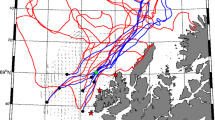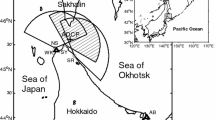Abstract
Ocean surface boundary layer dynamics off the southern coast of France in the NW Mediterranean is investigated by using velocity observations by high-frequency (HF) radars, surface drifting buoys and a downward-looking drifting acoustic Doppler current profiler (ADCP). The analysis confirms that velocities measured by HF radars correspond to those observed by an ADCP at the effective depth z f = k −1, where k is wavenumber of the radio wave emitted by the radar. The radials provided by the radars were in a very good agreement with in situ measurements, with the relative errors of 1 and 9 % and root mean square (RMS) differences of 0.02 and 0.04 m/s for monostatic and bistatic radar, respectively. The total radar-based velocities appeared to be slightly underestimated in magnitude and somewhat biased in direction. At the end of the survey period, the difference in the surface current direction, based on HF radar and ADCP data, attained 10°. It was demonstrated that the surface boundary layer dynamics cannot be reconstructed successfully without taking into the account velocity variation with depth. A significant misalignment of ∼30° caused by the sea breeze was documented between the HF radar (HFR-derived) surface current and the background current. It was also found that the ocean response to a moderate wind forcing was confined to the 4-m-thick upper layer. The respective Ekman current attained the maximum value of 0.15 m/s, and the current rotation was found to be lagging the wind by approximately 40 min, with the current vector direction being 15–20° to the left of the wind. The range of velocity variability due to wind forcing was found comparable with the magnitude of the background current variability.









Similar content being viewed by others
References
Abascal AJ, Castanedo S, Fernández V, Medina R (2012) Backtracking drifting objects using surface currents from high-frequency (HF) radar technology. Ocean Dyn 62(7):1073–1089
Ardhuin F, Marié L, Rascle N, Forget P, Roland A (2009) Observation and estimation of Lagrangian, Stokes, and Eulerian currents induced by wind and waves at the sea surface. J Physical Oceanography 39(11):2820–2838
Barrick D, Fernandez V, Ferrer MI, Whelan C, Breivik Ø (2012) A short-term predictive system for surface currents from a rapidly deployed coastal HF radar network. Ocean Dyn 62(5):725–740
Bellomo L, Griffa A, Cosoli S, Falco P, Gerin R, Iermano I et al (2015) Toward an integrated HF radar network in the Mediterranean Sea to improve search and rescue and oil spill response: the TOSCA project experience. Journal of Operational Oceanography 8(2):95–107
Berta M, Bellomo L, Magaldi MG, Griffa A, Molcard A, Marmain J et al (2014) Estimating Lagrangian transport blending drifters with HF radar data and models: results from the TOSCA experiment in the Ligurian Current (North Western Mediterranean Sea). Prog Oceanogr 128:15–29
Chapman RD, Graber HC (1997) Validation of HF radar measurements. OCEANOGRAPHY-WASHINGTON DC-OCEANOGRAPHY SOCIETY 10:76–79
Emery BM, Washburn L, Harlan JA (2004) Evaluating radial current measurements from CODAR high-frequency radars with moored current meters. J Atmos Ocean Technol 21(8):1259–1271
Forget P (2015) Noise properties of HF radar measurement of ocean surface currents. Radio Sci 50(8):764–777
Frolov S, Paduan J, Cook M, Bellingham J (2012) Improved statistical prediction of surface currents based on historic HF-radar observations. Ocean Dyn 62:1111–1122
Guihou K, Marmain J, Ourmières Y, Molcard A, Zakardjian B, Forget P (2013) New insight of the meso to sub-mesoscale dynamics in the North-Western Mediterranean Sea: a combined data-model approach. Ocean Dyn. doi:10.1007/s10236-013-0619-z
Gurgel KW, Antonischki G, Essen HH, Schlick T (1999) Wellen Radar (WERA): a new ground-wave HF radar for ocean remote sensing. Coast Eng 37:219–234
Harlan J, Terrill E, Hazard L, Keen C, Barrick D, Whelan C, Howden S, Kohut J (2010) The integrated ocean observing system high-frequency radar network: status and local, regional, and national applications. Mar Technol Soc J 44(6):122–132
Heron ML (2009) The Australian coastal ocean radar network facility. Proc. IEEE Can. Conf. Electr. Comput. Eng., St. John’s, Canada. New York, IEEE, pp. 23–26
Kim SY, Terrill EJ, Cornuelle BD (2009) Assessing coastal plumes in a region of multiple discharges: the U.S.–Mexico border. Environ Sci Technol 43:7450–7457
Kim SY, Cornuelle BD, Terrill EJ (2010) Decomposing observations of high-frequency radar-derived surface currents by their forcing mechanisms: locally wind-driven surface currents. J Geophys Res 115:C12046. doi:10.1029/2010JC006223
Kohut JT, Glenn SM, Paduan JD (2006) Inner shelf response to tropical storm Floyd. J Geophys Res 111(C9)
Kosro PM (2005) On the spatial structure of coastal circulation off Newport, Oregon, during spring and summer 2001 in a region of varying shelf width. J Geophys Res 110:C10S06
Lee PHY, Barter JD, Caponi E, Caponi M, Hindman CL, Lake BM, Rungaldier H (1996) Wind-speed dependence of small-grazing-angle microwave backscatter from sea surfaces. EEE Transactions on Antennas and Propagation 44(3):333–340
Marmain J, Molcard A, Forget P, Barth A (2014) Assimilation of HF radar surface currents to optimize forcing in the North Western Mediterranean Sea. Nonlin Processes Geophys 21:659–675
McWilliams JC, Fox-Kemper B (2013) Oceanic wave-balanced surface fronts and filaments. J Fluid Mech 730:464–490. doi:10.1017/jfm.2013.348
Millot C (1999) Circulation in the western Mediterranean Sea. J Marine Systems 20:423–442
Ohlmann JC, White PF, Sybrandy AL, Niiler PP (2005) GPS-cellular drifter technology for coastal ocean observing systems. J. of Atmospheric and Oceanic Technology 22(9):1381–1388
Ohlmann C, White P, Washburn L, Emery B, Terrill E, Otero M (2007) Interpretation of coastal HF radar-derived surface currents with high-resolution drifter data. J of Atmospheric and Oceanic Technology 24(4):666–680
Paduan JD, Cook MS (1997) Mapping surface currents in Monterey Bay with CODAR-type HF radar. Oceanography 10:49–52
Paduan JD, Shulman I (2004) HF radar data assimilation in the Monterey Bay area. J Geophys Res 109:C07S09. doi:10.1029/2003JC001949
Paduan JD, Washburn L (2013) High-frequency radar observations of ocean surface currents. Annu Rev Mar Sci 5:115–136
Price JF, Weller RA, Pinkel R (1986) Diurnal cycling: observations and models of the upper ocean response to diurnal heating, cooling, and wind mixing. J Geophys Res 91(C7):8411
Röhrs J, Sperrevik AK, Christensen KH, Broström G, Breivik Ø (2015) Comparison of HF radar measurements with Eulerian and Lagrangian surface currents. Ocean Dyn 65(5):679–690
Rypina II, Kirincich AR, Limeburner R, Udovydchenkov IA (2014) Eulerian and Lagrangian correspondence of high-frequency radar and surface drifter data: effects of radar resolution and flow components. J of Atm and Oceanic Technology 31(4):945–966
Schmidt RO (1986) Multiple emitter location and signal parameter estimation. IEEE Trans Antennas Propag AP-34:276–280
Stewart RH, Joy JW (1974) HF radio measurements of surface currents. Deep Sea Res 21:1039–1049
Suzuki, N., Fox-Kemper, B. (2016) Understanding Stokes forces in the wave-averaged equations. J Geophys Res: Oceans. In press
Teague CC, Vesecky JF, Hallock ZR (2001) A comparison of multifrequency HF radar and ADCP measurements of near-surface currents during COPE-3. IEEE J Ocean Eng 26(3):399–405
Thomson, R. E., Emery, W. J. (2014) Data analysis methods in physical oceanography. Newnes
Ullman, D. S., O’Donnell, J., Kohut, J., Fake, T., Allen, A. (2006) Trajectory prediction using HF radar surface currents: Monte Carlo simulations of prediction uncertainties. J Geophys Res 111(C12)
Wilkin JL, Arango HG, Haidvogel DB, Lichtenwalner CS, Glenn SM, Hedström KS (2005) A regional ocean modeling system for the long-term ecosystem observatory. J Geophys Res. doi:10.1029/2003JC002218
Yaremchuk M, Coelho E (2015) Filtering drifter trajectories sampled at mesoscale resolution. J Oceanic Engineering 40(3):497–505
Yaremchuk M, Sentchev A (2009) Mapping radar-derived sea surface currents with a variational method. Cont Shelf Res 29(14):1711–1722
Yaremchuk, M., Spence, P., Wei, M., Jacobs, G. (2013). Lagrangian predictability in the DWH region from HF radar observations and model output. Deep Sea Res II: Top Stud Oceanogr
Yaremchuk M, Spence P, Wei M, Jacobs G (2016) Lagrangian predictability in the DWH region from HF radar observations and model output. Deep-Sea Research II 129:394–400
Yoshikawa Y, Masuda A (2009) Seasonal variations in the speed factor and deflection angle of the wind-driven surface flow in the Tsushima Strait. J Geophys Res 114:C12022
Zelenke, B., Moline, M. A., Crawford, G. B., Garfield, N., Jones, B. H., Largier, J. L., ... & Washburn, L. (2009). Evaluating connectivity between marine protected areas using CODAR high-frequency radar. In Oceans. IEEE, pp. 1–10
Zhao J, Chen X, Hu W, Chen J, Guo M (2011) Dynamics of surface currents over Qingdao coastal waters in August 2008. J Geophys Res 116:C10020
Acknowledgements
The authors would like to acknowledge the support by the project LEFE “SUBCORAD” of the Institut Nationale des Sciences de l’Univers (INSU). The radar data were collected and processed at the Mediterranean Institute of Oceanography (MIO). We also acknowledge colleagues of MIO involved in the project: A. Molcard, J. Marmain, C. Quentin, Y. Barbin, L. Belomo and D. Malengros. The skill and experience of the skipper Eric Lecuyer and his help during the fieldwork are appreciated and acknowledged.
Author information
Authors and Affiliations
Corresponding author
Additional information
Responsible Editor: Alexander Barth
This article is part of the Topical Collection on the 48th International Liège Colloquium on Ocean Dynamics, Liège, Belgium, 23–27 May 2016
Rights and permissions
About this article
Cite this article
Sentchev, A., Forget, P. & Fraunié, P. Surface current dynamics under sea breeze conditions observed by simultaneous HF radar, ADCP and drifter measurements. Ocean Dynamics 67, 499–512 (2017). https://doi.org/10.1007/s10236-017-1035-6
Received:
Accepted:
Published:
Issue Date:
DOI: https://doi.org/10.1007/s10236-017-1035-6




